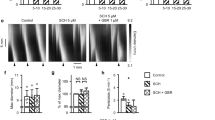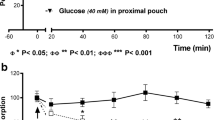Abstract
Duodenal mucosal secretion of bicarbonate is one main mechanism in the protection of this epithelium against luminal acid. The duodenal secretagogue vasoactive intestinal polypeptide, at doses not affecting mucosal blood flow, protects against acid-induced morphological changes. Some sigma receptor ligands, which increase the duodenal alkaline secretion, prevent duodenal but not gastric mucosal ulceration. Dopamine D-1 receptor agonists and the peripherally acting catechol-O-methyl-transferase (COMT) inhibitor nitecapone stimulate the bicarbonate secretion in the rat and a similar increase in secretion has been observed in human volunteers. COMT inhibitors decrease tissue degradation of catecholamines, including dopamine. The D-2 agonist bromocriptine, in contrast, decreases the secretion. These results, indicating that the bicarbonate secretion is stimulated via peripheral dopamine D-1 receptors, are supported by the finding that dopamine D-1 (but not D-2) agonists increase the production of cyclic AMP in isolated duodenal enterocytes. The increase in mucosal alkaline secretion may contribute to the previously observed ulceroprotective actions of dopaminergic compounds.
Similar content being viewed by others
References
Flemström G: Gastric and duodenal mucosal bicarbonate secretion.In Physiology of the Gastrointestinal Tract, 3rd ed. LR Johnson, DH Alpers, J Christensen, ED Jacobson, JH Walsh (eds). New York, Raven, 1994, pp 1285–1309
Isenberg JI, Selling JA, Hogan DL, Koss MA: Impaired proximal duodenal mucosal bicarbonate secretion in patients with duodenal ulcer. N Engl J Med 316:374–379, 1987
Mertz-Nielsen A, Hillingsø J, Eskerod O, Frøkier H, Bukhave K, Rask-Madsen J: Evidence for increased gastric PGE2 release and bicarbonate output secondary to a defective duodenal mucosal bicarbonate secretion in patients with duodenal ulcer. Gastroenterology 104:A146, 1993
Nylander O, Wilander E, Larson GM, Holm L: Vasoactive intestinal polypeptide reduces hydrochloric acid-induced duodenal mucosal permeability. Am J Physiol 264:G272-G279, 1993
Ainsworth MA: Duodenal mucosal bicarbonate secretion and its importance in relation to mucosal protection and neutralization of acid in the duodenum. Thesis. Odense University, Odense, Denmark, 1992
Pascaud XB, Chovet M, Soulard P, Chevalier E, Roze C, Junien JL: Effects of a new σ ligand, JO 1784, on cysteamine ulcers and duodenal alkaline secretion in rats. Gastroenterology 104:427–434, 1993
Sikiric P, Rotkvic I, Mise S, Petek M, Rucman R, Seiwerth S, Zjacic-Rotkvic V, Duvnjak M, Jagic V, Suchanek E, Grabarevic Z, Anic T, Brkic T, Djermanovic Z, Dodig M, Marovic A, Hernandez DE: Dopamine agonists prevent duodenal ulcer relapse. A comparative study with famotidine and cimetidine. Dig Dis Sci 36:905–910, 1991
Hernandez DE, Mason GA: Involvement of dopamine and dopamine receptors in stress gastric ulceration.In Ulcer Disease: New Aspects of Pathology and Pharmacology. S Szabo, CJ Pfeiffer (eds). Boca Raton, Florida, CRC Press, 1989, pp 207–215
Glavin G: Activity of selective dopamine DA1 and DA2 agonists and antagonists on experimental gastric lesions and gastric acid secretion. J Pharmacol Exp Ther 251:726–730, 1989
Glavin GB, Szabo S: Dopamine in gastrointestinal disease. Dig Dis Sci 35:1153–1161, 1990
MacNaughton WK, Wallace JL: A role for dopamine as an endogenous protective factor in the rat stomach. Gastroenterology 96:972–980, 1989
Aho PA, Lindén IB: Role of gastric mucosal eicosanoid production in the cytoprotection induced by nitecapone. Scand J Gastroenterol 27:134–138, 1992
Hernandez DE, Walker CH, Valenzuela JE, Mason GA: Increased dopamine receptor binding in duodenal mucosa of duodenal ulcer patients. Dig Dis Sci 34:543–547, 1989
Flemström G, Säfsten B, Jedstedt G: Stimulation of mucosal alkaline secretion in rat duodenum by dopamine and dopaminergic compounds. Gastroenterology 104:825–833, 1993
Knutson L, Knutson TW, Flemström G: Endogenous dopamine and duodenal bicarbonate secretion in humans. Gastroenterology 104:1409–1413, 1993
Säfsten B, Flemström G: Dopamine and vasoactive intestinal peptide stimulate cyclic adenosine-3′,5′-monophosphate formation in isolated rat villus and crypt duodenocytes. Acta Physiol Scand 149:67–75, 1993
Schultz E, Nissinen E: Inhibition of rat liver and duodenal soluble catechol-O-methyltransferase by a tight-binding inhibitor OR-462. Biochem Pharmacol 38:3953–3956, 1989
Nissinen E, Lindén IB, Schultz E, Kaakkola S, Männistö PT, Pohto P: Inhibition of catechol-O-methyltransferase activity by two novel disubstituted catechols in the rat. Eur J Pharmacol 153:263–269, 1988
Graffner H, Ekelund M, Håkanson R, Rosengren E: Effect of different denervation procedures on catecholamines in the gut. Scand J Gastroenterol 20:1276–1280, 1985
Dawirs RR, Teuchert-Noodt G, Kampen WU: Demonstration of dopamine-immunoreactive cells in the gastrointestinal tract of gerbils (Meriones unguiculatus). J Histochem Cytochem 40:1197–1201, 1992
Author information
Authors and Affiliations
Additional information
This work was supported by the Swedish Medical Research Council (grant 04X-3515) and the Swedish Society for Medicine (grants 846.0 and 915.0), Stockholm, Sweden.
Rights and permissions
About this article
Cite this article
Flemström, G., Säfsten, B. Role of dopamine and other stimuli of mucosal bicarbonate secretion in duodenal protection. Digest Dis Sci 39, 1839–1842 (1994). https://doi.org/10.1007/BF02088112
Received:
Accepted:
Issue Date:
DOI: https://doi.org/10.1007/BF02088112




